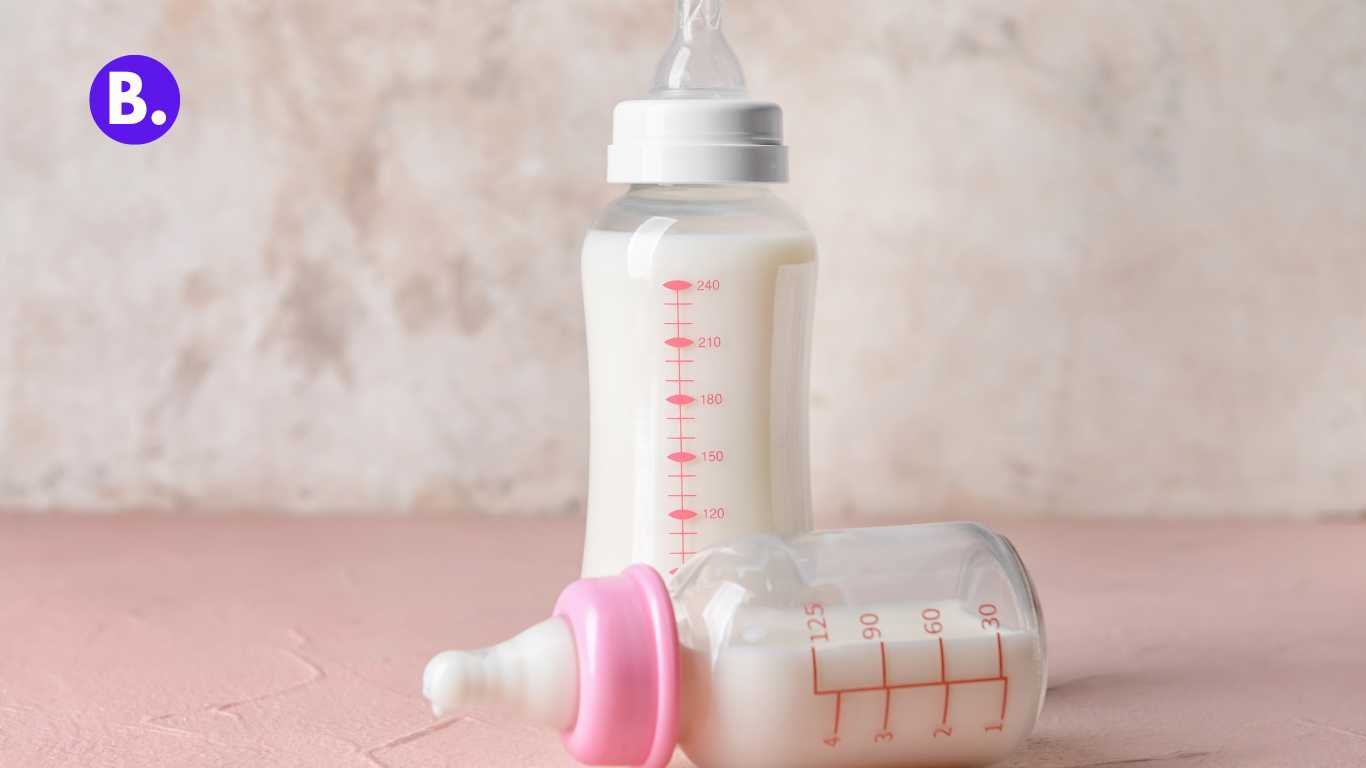When preparing your baby registry, it’s common to receive numerous suggestions from friends, family, and even strangers about essential items you supposedly need for your baby’s first year. However, the truth is that there are only a few key essentials you truly need when bringing your baby home from the hospital, and having the right bottles is often at the top of the list, especially the best baby bottles for newborns.
Whether you plan to formula feed or use a combination of breastfeeding and bottle feeding, you’ll likely be using bottles multiple times a day, sometimes as frequently as 8-10 times during the early days. Even if you intend to breastfeed exclusively, you may still need bottles for pumping and for occasions when you cannot feed directly, such as when returning to work or when another caregiver needs to feed your baby. Consequently, choosing the right baby bottles is a crucial decision that shouldn’t be taken lightly.
We understand that baby bottles come in a wide range of shapes, sizes, and features to cater to your baby’s needs. To help you in finding the best baby bottle that suits both you and your baby, we have compiled a list of the best baby bottles of the year, as well as you can also check out our drying racks, bottle warmers, and breast milk storage bags.
How do we choose our picks for the best baby bottles?
When selecting baby bottles, we took into consideration a diverse range of options with varying sizes, shapes, and features to cater to different needs.
We also prioritized bottles that offer additional benefits for parents, such as easy cleaning and convenient storage design. The shape and feel of the nipple were important factors, as they play a crucial role in facilitating a successful transition from breastfeeding to bottle feeding, ensuring a secure latch.
Our Favorite Best Baby Bottles
Here are the top recommendations for baby bottles to consider when feeding your little one.
- Best Overall: Comotomo Baby Bottle
- Best for Preemies and Newborns: Dr. Brown’s Natural Flow Baby Bottle
- Best Bottle for Breastfed Baby: Lansinoh Breastfeeding Bottles with NaturalWave Nipple
- Easiest Baby Bottle to Sterilize: MAM Easy Start Anti-Colic Bottles
- Best Glass Baby Bottle: Philips AVENT Natural Glass Baby Bottle
- Best Slow Flow Bottle: Tommee Tippee Closer to Nature Baby Bottle
- Best Anti-Colic Bottles: NUK Smooth Flow Anti-Colic Baby Bottles
- Best Silicone Baby Bottles: Boon NURSH Reusable Silicone Bottles
- Best Bottle for Formula: PopYum Anti-Colic Baby Bottles
- Best Baby Bottles for Pumping Moms: Medela Breast Milk Storage Bottles
- Best East To Clean Baby Bottle: Olababy Gentle Baby Bottle
- Best Hybrid Baby Bottle: Chicco Duo Newborn Hybrid Baby Bottle
- Best Baby Bottle Gift Set: Hegen Bottle Starter Gift Set
1. Best Overall: Comotomo Baby Bottle
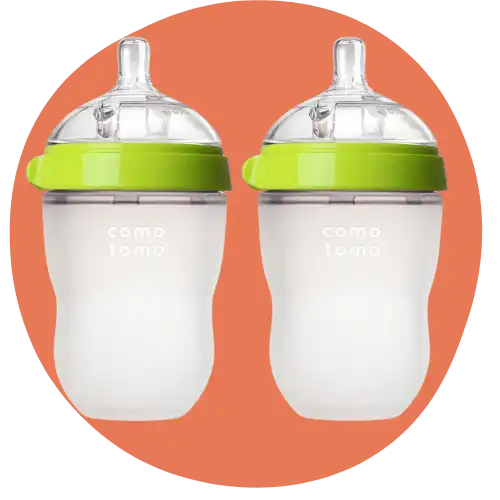
The Comotomo Bottle is highly recommended when introducing a bottle to an exclusively breastfed baby. Its soft, silicone material closely mimics the breast, making it easier for babies to transition. The wide-neck design allows for easy filling and mixing of breast milk or formula with minimal spills. Cleaning is simple as the silicone nipple is easy to remove and there are few crevices for milk to get stuck in. The bottle is dishwasher-safe (top rack) and microwave-safe for added convenience.
In leak tests and everyday use, the Comotomo Bottle proved to be reliable and durable. Its slightly squishy design also makes it simpler to store if comparing to other bottles. Additionally, it doesn’t retain the sour-milk smell that can sometimes occur with plastic bottles. With its high ratings and over 17,000 reviews on Amazon, it’s evident that many parents agree that the Comotomo Bottle is a top choice.
The Comotomo Bottle comes in various colors, and there’s also an option to purchase a transitional sippy cup spout for future use.
Pros
Cons
2. Best for Preemies and Newborns: Dr. Brown’s Natural Flow Baby Bottle
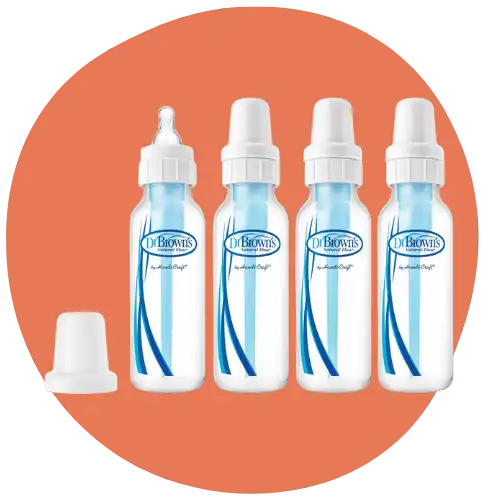
When it comes to finding the best bottles for newborns or preemies, Dr. Brown’s Original Baby Bottles are often recommended by doctors and NICU professionals. These bottles feature a slow-flow nipple design that aims to reduce colic and spit-up, making them a popular choice.
Dr. Brown’s bottles come with a filter and offer a controlled flow rate, allowing babies to drink at their own pace. As your baby becomes more skilled at bottle feeding, you can transition to larger nipple sizes. Typically, starting with a preemie nipple and then gradually progressing to larger sizes every few months is recommended.
Dr. Brown’s bottles are typically reliable in terms of leakage when properly sealed. However, after approximately six months of use, a few users have experienced occasional drips during car trips. While these bottles may not provide an exact breast-like experience, they still offer a relatively easy latch, particularly for babies who have been using bottles since birth.
One aspect to consider when using Dr. Brown’s bottles is their tall and skinny configuration, which can make cleaning a bit challenging. However, the set typically includes wire cleaners specifically designed for cleaning the filters and using a good bottle brush can significantly help in reaching all the nooks and crannies. While the skinny neck may make filling and mixing formula a bit more difficult compared to some other bottles, it is not overly problematic. Some parents choose to use a funnel to simplify the process.
It’s important to note that Dr. Brown’s bottles have multiple separate parts, including the filter, cap, nipple, and bottle, which can be taken apart for cleaning. It’s crucial to clean all the components thoroughly to avoid any leftover bits of formula or dried milk in the crevices, which could result in a sour smell over time.
Pros
Cons
3. Best Bottle for Breastfed Baby: Lansinoh Breastfeeding Bottles with NaturalWave Nipple
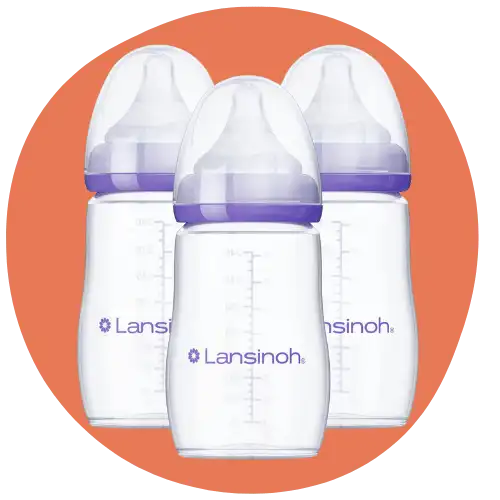
The Lansinoh bottles proved to be satisfactory in our experience—not exceptional, but not problematic either. The bottle design is user-friendly for older children to hold, and the nipple shape, which incorporates a “unique air venting system” to reduce colic, aims to mimic breastfeeding and was relatively easy for our baby to latch onto. However, it’s worth noting that if the baby leans their cheek against the nipple, as they might while nursing, it can create pressure on the bottle and lead to the formation of air bubbles.
In terms of cleaning, the Lansinoh bottles were relatively easy to maintain as they have minimal parts, including the nipple, cap, and bottle. The wide neck of the bottle allows for convenient filling as well. During leak testing, they performed well and didn’t exhibit any stray drips.
Pros
Cons
4. Easiest Baby Bottle to Sterilize: MAM Easy Start Anti-Colic Bottles
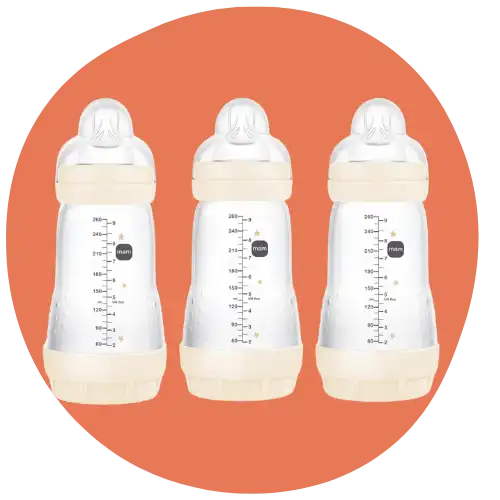
MAM bottles stand out from the crowd with their unique and innovative features. One standout feature is the vent located on the bottle’s base, which helps regulate milk flow and reduces discomforts like gas and colic. But that’s not all! MAM bottles also come with a built-in sterilization system that is incredibly convenient. Just remove the base, add an ounce of water, place the nipple inside, and pop it all in the microwave for three minutes. No need for a separate bottle sterilizer anymore!
And let’s not forget about the delightful designs and colors that parents adore. While your little one might not notice just yet, you’ll love the fun and whimsical styles available. This starter set includes two five-ounce bottles, two nine-ounce bottles, two self-sterilizing pacifiers, a pacifier clip, and a bottle brush. It’s everything you need to get started with feeding in style.
Pros
Cons
5. Best Glass Baby Bottle: Philips AVENT Natural Glass Baby Bottle
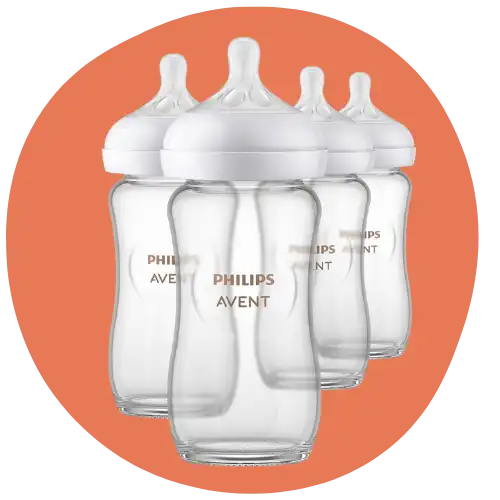
If you’re worried about potential chemicals in baby bottles, choosing glass bottles is a fantastic option because they are naturally free of BPA. With the Philips set of glass baby bottles, you can have peace of mind knowing that they are made from high-quality borosilicate glass, which can be safely warmed and stored in the fridge. The nipple included in this set has a clever no-drip design and is shaped like a breast, making it super convenient for both breastfeeding babies and those who use formula. What’s more, these bottles come with an anti-colic valve to help reduce tummy troubles and fussiness. And the best part? They fit perfectly in the side pocket of your diaper bag, making them a breeze to take on the go!
Pros
Cons
6. Best Slow Flow Bottle: Tommee Tippee Closer to Nature Baby Bottle
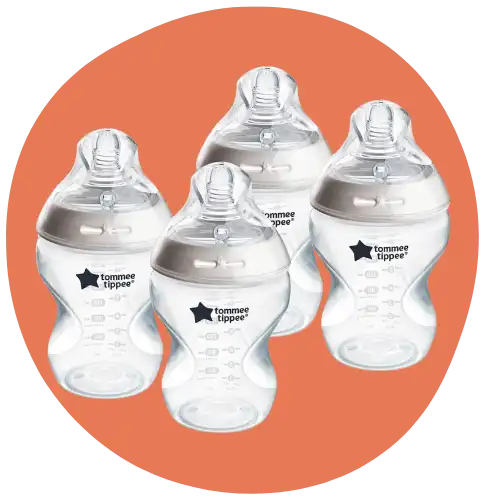
Both breastfeeding and formula-feeding parents appreciate the shape of these baby bottles, as they mimic the breast with their soft, silicone material and wide-necked nipple. This unique design not only provides a natural feel for the baby but also makes it easy for caregivers to hold while feeding. The bottles are very easy to clean—just put them in the dishwasher—and have an anti-colic lock that keeps air from escaping too much. For newborns and younger babies who require a slower flow, Tommee Tippee bottles are an excellent choice. Designed to replicate the shape and movement of a breast, the soft silicone nipple flexes during feeding, allowing for a natural latch and controlled milk flow. The bottles’ curvy design ensures a comfortable grip for both babies and parents, while their wide width and minimal parts simplify the cleaning process.
Pros
Cons
7. Best Anti-Colic Bottles: NUK Smooth Flow Anti-Colic Baby Bottles

When it comes to reducing colic, this particular bottle brand stands out among the rest. Its secret lies in the innovative design of the bottle nipple, which allows milk to flow slowly and at a pace that is gentle on a baby’s sensitive digestive system. Furthermore, these bottles have a special SafeTemp sign that changes color based on the milk’s temperature. This eliminates the need for constant wrist testing as the icon on the bottle will indicate whether the milk is too hot or at a safe temperature for feeding. With NUK Smooth Flow Bottles, you can ensure colic-free feeding and peace of mind. (How to properly warm up a baby bottle).
Pros
Cons
8. Best Silicone Baby Bottles: Boon NURSH Reusable Silicone Bottles
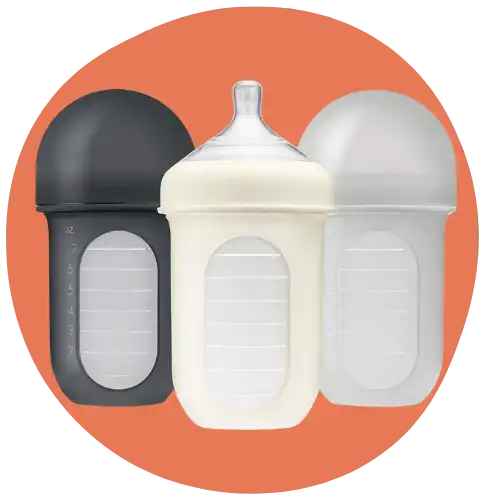
Another excellent option in the realm of silicone bottles is Boon. What sets Boon apart is its innovative silicone pouch that collapses and shrinks as your baby drinks. This feature not only helps reduce gas but also closely replicates the natural deflating of the breast during feeding, making it an ideal choice for nursing parents. Additionally, Boon bottles are made from PVC- and BPA-free silicone, ensuring they are safe for your baby. Cleaning them is a breeze as they are 100 percent dishwasher safe. Boon bottles combine functionality, convenience, and safety for a great feeding experience.
Pros
Cons
9. Best Bottle for Formula: PopYum Anti-Colic Baby Bottles

If you’ve ever dealt with formula feeding, you know it can be quite a task. While it may have its advantages over breastfeeding, it also comes with its own challenges.
The constant measuring, mixing, and ensuring you have sanitized bottles ready can be overwhelming. Not to mention the need to pack enough formula in your diaper bag and keep the milk at the right temperature.
But here’s where the PopYum bottle comes to the rescue! This bottle features a handy funnel that makes loading the formula a breeze. No more worries about the formula falling into the water chamber.
The best part? You can prepare a bottle with just one hand! The bottle cleverly stores the formula and water separately, allowing you to set it up in advance. When your baby needs a feed, simply press the buttons on the bottle, give it a shake, and it’s ready to go.
Breastfeeding moms, we’ve got something for you too! This cool bottle is perfect for storing and isolating breast milk at the bottom. The milk won’t come into contact with the nipple or vents until you’re ready. How convenient is that?
Say goodbye to stumbling with formula and hello to an easier way to feed your baby: the PopYum bottle. Happy baby, happy mom!
Pros
Cons
10. Best Baby Bottles for Pumping Moms: Medela Breast Milk Storage Bottles
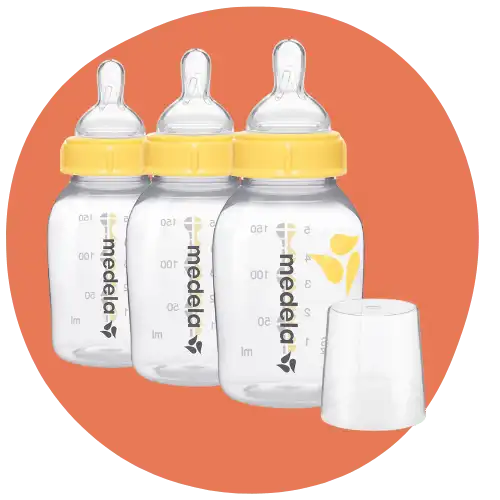
The Medela Breast Milk Bottle Set is a comprehensive solution for collecting, storing, and feeding breast milk. These bottles are made from BPA-free, safe plastic that preserves the beneficial properties of breast milk. Compatible with all Medela breast pumps, they eliminate the need for transferring milk, allowing you to pump, store, and feed with a single container. Available in 5 oz or 8 oz sizes, these bottles feature clear ounce and millimeter markers for precise measurement.
They are dishwasher and microwave-safe, providing convenience for busy moms. The set includes three bottles, three solid lids, three slow-flow silicone nipples, three wide base collars, and travel caps to keep the nipples clean while on the go. It also comes with a Quick Clean Micro-Steam Bag for easy disinfection. It’s important to handle the bottles and components with care to prevent damage. Medela’s bottle system simplifies the pumping journey, making it more efficient and hassle-free.
Pros
Cons
11. Best East To Clean Baby Bottle: Olababy Gentle Baby Bottle
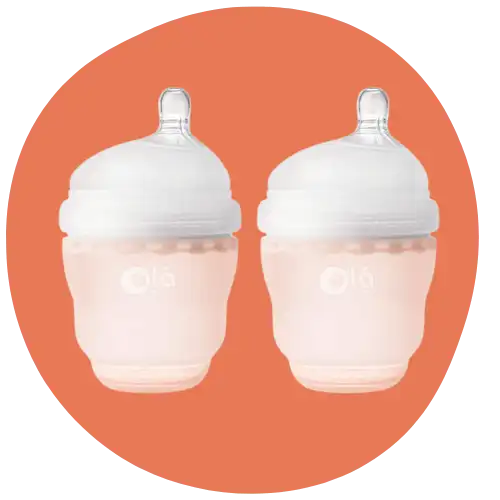
This highly popular bottle stands out with its unique features that are loved by parents and babies alike. Crafted from soft silicone, it offers a lightweight and easy-to-hold design for both you and your little one. The wide neck allows for effortless cleaning, while the built-in anti-colic vents help reduce air intake during feeding. However, the standout feature is the off-centered nipple, designed to mimic the natural breastfeeding experience. This innovative design promotes upright feeding, which is especially beneficial when bottle-feeding a breastfed baby, and aids in achieving a better latch for optimal feeding sessions.
Pros
Cons
12. Best Hybrid Baby Bottle: Chicco Duo Newborn Hybrid Baby Bottle
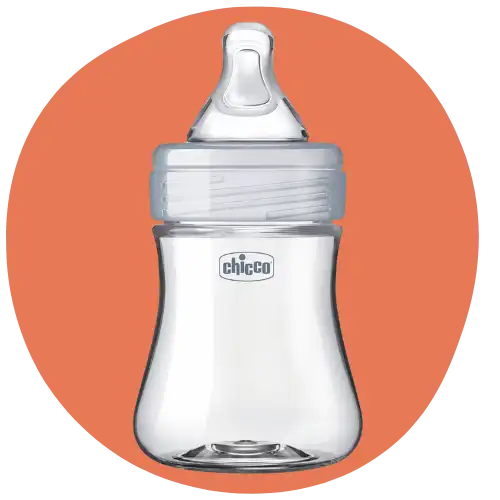
Introducing a unique bottle that blends the purity of glass with the convenience of plastic. With its glass interior, your baby’s milk only comes in contact with the safest material. Meanwhile, the shatterproof and lightweight plastic exterior ensures durability. Plus, this bottle is dishwasher, bottle warmer, and sterilizer safe.
This starter set includes two five-ounce and two nine-ounce bottles, along with two Stage 1 Slow-Flow Nipples, two Stage 2 Medium-Flow Nipples, and two PhysioForma Silicone Orthodontic Pacifiers.
Pros
Cons
13. Best Baby Bottle Gift Set: Hegen Bottle Starter Gift Set
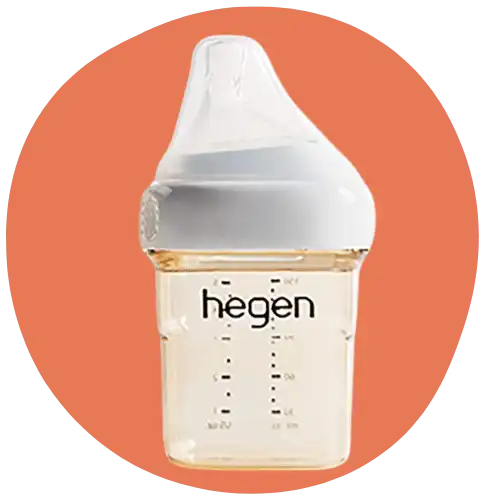
This gift box is not only stylish and beautifully packaged but also guaranteed to bring a smile to any new parent’s face. However, Hegen bottles offer much more than just good looks. These innovative “sqround” (square + round) baby bottles feature an off-centered, elongated nipple that closely mimics the natural breast shape, along with a venting system to prevent gas and colic. In addition, they are stackable, which helps save valuable space, and the no-screw lid is designed for easy press-to-close and twist-to-open functionality. Moreover, these bottles are made from a unique material that combines the benefits of both plastic and glass, allowing you to safely freeze or heat up milk directly in the bottle.
The twist and press lid is undeniably a cool and unique feature, although it may require a little practice to get used to. It’s worth the effort, though. Admittedly, these bottles are priced on the higher side compared to others. However, when you consider their impressive features, durability, and convenience, they are truly an investment in your baby’s comfort and peace of mind.
Pros
Cons
Is it Necessary to Have Baby Bottles?
Baby bottles are an essential tool for many families. Whether you’re feeding your baby formula or planning to return to work during the first year, they become a necessity. Additionally, if you’ll be away from your little one for an extended period and need others to feed them, bottles are indispensable.
Even if you choose to exclusively breastfeed and stay at home, there’s a potential win-win situation. Allowing other family members to feed your baby pumped milk using a bottle gives them an opportunity to bond with your little one while offering you a well-deserved break. It’s a great way to share feeding responsibilities and create special moments for everyone involved.
Do I Need Many Bottles?
If you plan on exclusively bottle-feeding your baby, it’s recommended to have between 6 to 12 baby bottles readily available. This ensures that you always have a bottle prepared for immediate use while others are being cleaned.
On the other hand, if you’ll only be using bottles occasionally, having 3 to 4 bottles should be enough to meet your needs. It’s important to strike a balance between having an adequate supply and managing the cleaning and maintenance of the bottles effectively.
When Do I Need To Start Using Baby Bottles?
You can start using bottles right from day one. However, if you’re exclusively breastfeeding, it is generally recommended to wait until your baby has established a good nursing routine, usually around three to six weeks, before introducing a bottle.
While the American Academy of Pediatrics suggests transitioning to cow’s milk around one-year-old, many breastfeeding parents continue nursing well into the second year and beyond if it aligns with their personal choices and the needs of their child.
Types of Baby Bottles
Baby bottles are commonly made from three main materials: glass, plastic, or silicone.
Glass Baby Bottles
Glass baby bottles were the go-to choice in the past before the advent of plastic, and they have made a comeback in popularity. Although it may initially raise some eyebrows, it’s important to note that modern glass baby bottles are made from tempered glass, which is highly durable and designed to withstand accidental drops and rough handling.
Plastic Baby Bottles
Polypropylene, a sturdy type of plastic, is commonly used to make plastic baby bottles. Plastic bottles are the most prevalent and cost-effective option available, making them the most commonly found type of baby bottle in the market.
Silicone Baby Bottles
The newest addition to the baby bottle family is the silicone bottle. These bottles are crafted from silicone, a soft and flexible material that is free from harmful chemicals such as BPA, PVC, and Phthalate. Silicone bottles provide a safe and reliable option for feeding your baby.
Types of Baby Bottle Nipples
Baby bottle nipples are available in various sizes, each offering a different milk flow rate.
Newborn and slow-flow nipples are specifically designed for newborns and younger babies. These nipples provide a slower flow of milk or formula, ensuring that the baby doesn’t consume too much too quickly.
On the other hand, faster-flow nipples are intended for older babies who have developed stronger swallowing skills and can handle a faster flow of liquid.
Baby Bottle Sizes
Bottles typically come in two sizes to accommodate the needs of babies at different stages:
Smaller-sized bottles, typically around four ounces, are designed for newborns who consume smaller amounts of milk or formula during each feeding.
Larger bottles, with a capacity of approximately eight ounces, are suitable for older babies who have increased their intake and require larger feedings.
What size baby bottle do I need?
As a reference point, newborns typically consume around one to two ounces per feeding, while babies around six months old may consume six to eight ounces. Some parents prefer to have a combination of smaller and larger bottles, while others opt for larger bottles from the beginning and adjust the filling level to about halfway during the initial months. This allows for flexibility in meeting the changing needs of the baby’s appetite.
How to Choose a Baby Bottle
When it comes to baby bottles, each type has its own advantages and disadvantages. With numerous options available, comparing every minor detail can be overwhelming. To simplify your decision-making process for adding bottles to your baby registry, here are some fundamental pros and cons to consider.
Glass Bottles
Pros: Glass bottles have the advantage of not absorbing colors or odors, which can occur with silicone and plastic bottles. They also possess thermal shock resistance, allowing them to withstand extreme temperature changes without breaking. Additionally, glass bottles can be safely placed in the dishwasher without concerns of chemical leaching. Moreover, they are often easier to clean compared to other bottle types due to their simpler design with fewer parts.
Cons: Glass bottles have the drawback of being heavier, making them trickier for both parents and babies to hold. While they are not extremely fragile, they can still break if mishandled. Additionally, glass bottles tend to be pricier compared to other bottle types. Furthermore, due to their less widespread use, there are fewer options available for glass bottles compared to the more ubiquitous plastic bottles.
Plastic Bottles
Pros: When it comes to plastic bottles, there is an abundance of options to choose from when creating your baby registry. Plastic bottles also offer the advantage of being the most affordable type available. They are lightweight, making them convenient for both parents and babies to hold, and they won’t break easily if dropped.
Cons: Initially, there were concerns regarding plastic baby bottles due to the presence of bisphenol A (BPA), an industrial chemical used in certain plastics that was believed to have potential negative health effects. Unfortunately, in 2012, the FDA did something about it and banned BPA from all sippy cups and baby bottles. Despite this, the American Academy of Pediatrics (AAP) states that there are still ongoing discussions and uncertainties regarding the health and safety concerns associated with plastics, especially in children, particularly when exposed to heat.
If you opt for plastic baby bottles, it is advisable to refrain from microwaving them and instead chooses to hand-wash dirty bottles rather than using a dishwasher. Many plastic bottles also come with numerous small parts, which can be a hassle when it comes to cleaning them.
Silicone Bottles
Pros: Silicone bottles have a soft and spongy texture that closely resembles a breast, making them easy to grip for both parents and babies. These bottles are unbreakable and do not contain many of the chemicals found in plastic bottles. They are also dishwasher safe and typically have fewer parts, simplifying the cleaning process.
Cons: Silicone bottles tend to be among the pricier options available and have a limited variety to choose from. While they do not contain the same chemicals as plastic bottles, there are still concerns about potential leaching at very high temperatures. Over time, silicone bottles can also discolor and absorb odors, which may affect their appearance and aroma.
7 Things to Consider When Buying a Baby Bottle
Have to be easy to assemble and fill
Assembling the bottle should be a straightforward process, typically involving inserting a nipple and screwing on the top. The bottle needs to have a wide enough mouth that allows for easy pouring of milk without spillage. Additionally, if you’re using powdered formula, the bottle should facilitate easy stirring. A useful tip is to use a chopstick for this purpose.
Have to be easy to wash
When selecting a bottle, prioritize a shape that facilitates easy cleaning. Cracks and corners in the bottle can trap sour milk or excess formula powder, resulting in unpleasant odors and potentially compromising the bottle’s safety for your baby. While many bottles are dishwasher-safe, we recommend opting for bottles with a wider neck shape. This design makes them more accessible for a thorough cleaning using a reliable bottle brush.
Have to be leak-free
Discovering a spilled puddle of breastmilk on the car floor next to a tipped-over bottle can be extremely frustrating. To avoid such mishaps, we focused on finding bottles that provided a secure and leak-proof seal, even when shaken or accidentally dropped. Most bottles we considered came with lids, and we ensured that they were sealed tightly and remained securely attached during transportation.
Have to be durable
You should be focused on selecting a bottle that could withstand daily use for several months without developing odors or cracks, ensuring long-lasting durability and functionality.
Have to be easy to store
While storing baby bottles may not be entirely convenient, we chose options that could be easily tucked into bins, drawers, or stored in the pockets of a diaper bag for added convenience.
Your baby needs to like it
Determining a baby’s nipple preference is subjective, often influenced by the shape of the mother’s breast. However, taking into account online reviews and personal experiences, we observed that certain nipple shapes were generally easier for most babies to latch onto. Nipples with wider, shallower shapes and a skinnier teat tended to provide a more comfortable experience.
Additionally, nipples that had slight flexibility, mimicking a mother’s breast, were often well-received by babies.
You may need colic-free technology
Certain bottles, such as Dr. Brown’s, incorporate anti-colic vents to regulate the amount of milk your baby consumes and minimize gas or air bubbles in their stomach. While this feature may not be essential for older babies, pediatricians commonly recommend it for infants under 6 months of age, particularly for those born prematurely.
Bottom line
In summary, when selecting the best baby bottles and other essential for your successful feedings, consider factors such as material (e.g., glass, plastic, silicone), ease of cleaning, leak-proof design, durability, nipple shape preference, and any additional features like anti-colic vents.
Choosing bottles that align with your baby’s comfort and convenience will ultimately contribute to a positive feeding experience.

